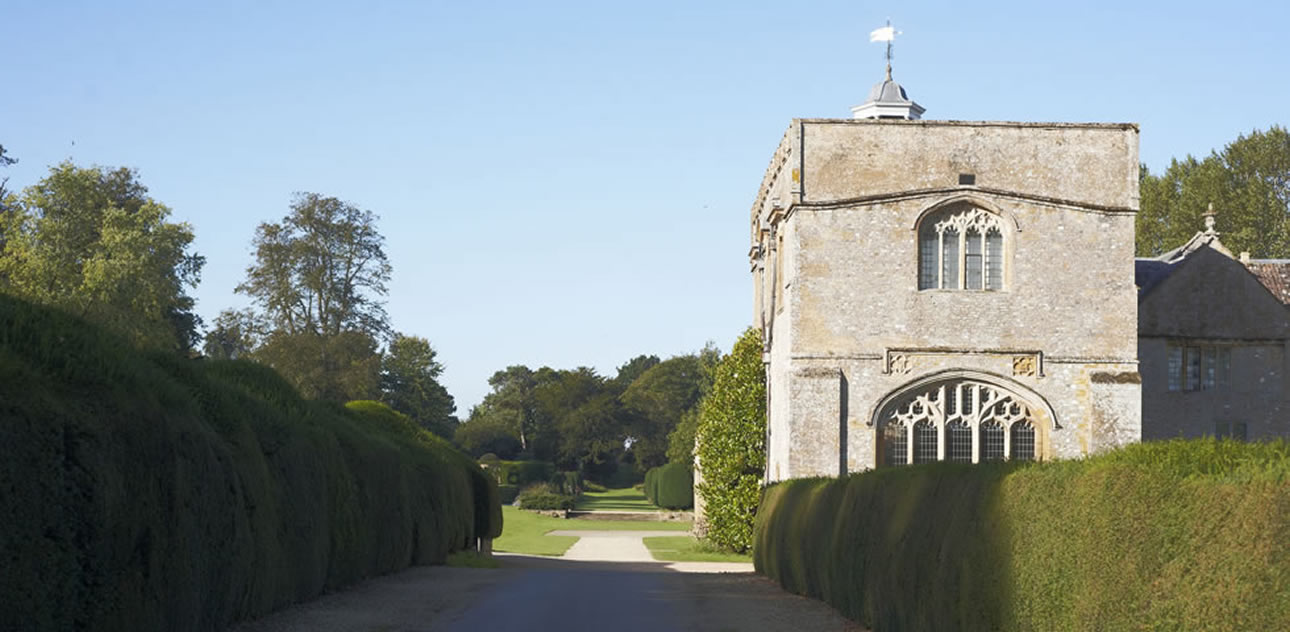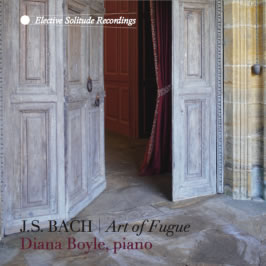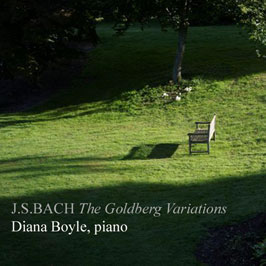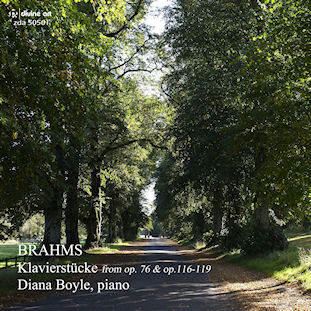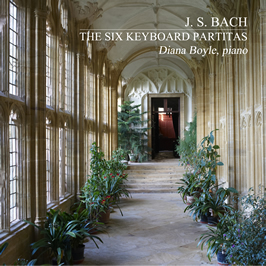Divine Art Intangible Classics ZDA 50503 Bach: Goldberg Variations
British pianist Diana Boyle is not well known in Italy but is considered one of the best pianists of old Albion. Her discography reveals that her activity is established definitely around the classical period given that her interpretative focus is on Bach, Mozart, Beethoven and Brahms – a line drawn from the base of tonal language, passing through the development of the Vienna School until reaching the composer who having drawn fully on Classicism closes the door of Romanticism to open the way for modernity – a path for the artist who lives in seclusion in southern Portugal who conducts a coherent search, reflecting and meditating, in order to establish her artistic and aural approach. And so here the two recordings we are considering represent the alpha and omega of that narrative thread of repertoire, Bach’s Goldberg Variations and a miscellanea of Brahms’s piano works.
The Bach recording cannot be counted among the increasing number of ‘scrupulously philological’ (“authentic period”) recordings not only for the use of a modern piano. Boyle mentions three points which underscored her point of view to this work: first, as is her habit, she avoided listening to any other recording of the work while studying it, even that of her inspiration, Glenn Gould; second she did not study the work in chronological order but from the Canons, then to the slower, more lyrical sections; third, that in order to understand the work fully she also needed fully to understand the even greater masterpiece of Bach, the Art of Fugue, which she considers the most indispensable work in his output. Now, given these three aspects of her view, we can understand fully her particular interpretation. Compared with the other recordings from the historical ones of Turek and Gould, her result is not typical because her interpretation and the fluency of her musical speech is highly influenced by a very careful, pronounced way of phrasing. For Diana Boyle, the Goldbergs are not a set of separate segments, but a continuous narrative line, and to emphasise this ‘speech’ pattern, uses much rubato (contrary to the likes of the ‘purists’) in a way reflecting the thinking and performance style of the Vienna School and Romantics. So the fragmentary Variations become a continuous flow within which the alternation of the variations appear like scenes on which to pin the phrases: a legato, a rubato.. which again prepare the listener for the format of the later and great work, the Art of Fugue.
Boyle can stretch the tempo changes so that ‘slow’ becomes slower, reflective and meditative; allegro is accentuated by use of pedals; there is a feeling of dance that reminds us of rococo style, and unexpected dynamic changes (ff to pp) which especially emphasise the passage from tonic to dominant, have almost a theatrical connotation and definitely display a Romantic approach, as examples variation 26 and Quodlibet which almost takes the aspect of a Ländler.
Andrea Bedetti (CD Classico)
June 2017
CD CLASSICO (ITALIA)
ZDA 50501 – ZDA 50503
La pianista londinese Diana Boyle non è molto conosciuta nel nostro Paese, ma in terra anglosassone viene considerata una delle migliori pianiste d’Albione. Il suo palmarès discografico, d’altronde, testimonia di una feconda attività che verte su un repertorio decisamente classico, visto che l’attenzione interpretativa di questa artista si è concentrata su Bach, Mozart, Beethoven e Brahms, quindi una linea che parte dalle fondamenta del linguaggio tonale, passa attraverso lo sviluppo di due esponenti della Scuola di Vienna fino ad arrivare a colui che, dopo aver attinto a piene mani dal Classicismo passato, chiude la porta del Romanticismo per aprire (come avrà modo poi di intuire Schönberg in suo famoso saggio) quella della modernità. Un tragitto frutto di una ricerca coerente, dapprima riflettuta, meditata (Diana Boyle conduce una vita molto appartata nel sud del Portogallo a contatto diretto con la natura) e poi riversata sul piano artistico e sonoro. E le due registrazioni prese in esame rappresentano, in un certo senso, l’alfa e l’omega di quel filo narrativo dato dal repertorio fissato discograficamente, vale a dire le Variazioni Goldberg di Bach e una miscellanea di lavori pianistici di Brahms.
Cominciamo dalla registrazione bachiana, la quale non può ovviamente essere ascritta nell’alveo, sempre più numeroso, delle letture scrupolosamente filologiche e non solo per l’uso di uno strumento “moderno” come il pianoforte. Nelle note di copertina la stessa Boyle mette in luce tre punti che servono anche a comprendere meglio la sua lettura di quest’opera: la prima è che, come suo costume, prima di registrare le Goldberg non ha ascoltato nessuna delle diverse edizioni passate, a cominciare da quelle di Gould; la seconda è che l’approccio e lo studio di quest’opera non sono avvenuti in sequenza numerica, partendo dall’Aria, ma dai Canoni per poi passare ai brani più lenti e più lirici; la terza è che considera lo studio e la registrazione delle Goldberg (il suono è stato catturato nel giugno del 2003, ma la sua pubblicazione risale solo al gennaio di quest’anno) le sono serviti moltissimo per comprendere e affrontare meglio la registrazione di un altro capolavoro bachiano, ossia l’Arte della Fuga, da lei considerata l’opera imprescindibile di tutta la concezione musicale del sommo Kantor. Ora sulla base di questi tre aspetti, si può cogliere meglio le peculiarità interpretative della sua lettura. Una lettura che, rispetto, appunto, a quelle affrontate da altri artisti, a cominciare da quelle “storiche” della Tureck e di Gould, potrebbe risultare atipica, in quanto privilegia fondamentalmente, a livello di inquadramento generale dell’opera, un assunto discorsivo, nel quale la fluidità dell’eloquio musicale viene sancito da un uso molto attento, marcato, oserei dire, del fraseggio. Per Diana Boyle le Goldberg sono una linea continua più che tanti segmenti, e per valorizzare questa “discorsività” punta sul rubato (da qui possibili storcimenti di naso da parte dei “puristi”), proiettando il lavoro su una dimensione che sarebbe rientrata pienamente nel tipo di concezione (e di esecuzione) che ne avrebbero avuto gli esponenti della Scuola di Vienna e buona parte di quelli del movimento romantico. Da qui, ecco che la frammentazione data dalle variazioni si trasforma in un flusso di continuità al cui interno l’alternarsi delle variazioni stesse assume la visione di tappe, di “stazioni” su cui plasmare un fraseggio, un legato, un rubato, tale da preparare l’esecutore e l’ascoltatore all’opera successiva e finale, ossia l’Arte della Fuga. Senza contare i cambi di tempo che a volte tendono a estremizzarsi (lenti più lenti, riflessivi e meditabondi, ed allegri accelerati con uso di pedali), approcci resi danzanti contrassegnati da un sapore che ricorda il rococò, cambi repentini di timbrica (dal ff al pp), che esasperano il passaggio dalla tonica alla dominante e che immettono nell’elaborazione interpretativa un connotato quasi “teatrale” e decisamente à la page con il respiro interiore romantico (vedasi variazione 26 e il Quodlibet che assume i contorni di un Ländler).
Per ciò che riguarda l’omega, ossia il disco con lavori pianistici brahmsiani, Diana Doyle ha scelto brani dall’Opp. 76, 116, 117, 118 & 119 e anche in questo caso si tratta di registrazioni effettuate più di vent’anni fa (risalgono esattamente all’ottobre del 1994). La chiave data dalla pianista inglese è quella di una più che evidente instabilità che tende a spostare l’ago della bilancia più sul versante romantico che su quello classico. Anche qui una timbrica che viene usata come “stato d’animo”, con un’agogica che viene sollecitata (Intermezzo in mi bemolle minore, Op. 118, n 6 & Intermezzo in si bemolle maggiore, Op. 76, n. 4). Un’instabilità sulla quale Diana Boyle va a investire soprattutto quattro pietre miliari della maturità pianistica brahmsiana, ossia i primi due Intermezzi dell’Opp. 117 & 119, caricandoli di una patina di pathos e trasformandoli in un ricettacolo sonoro nel quale convergono le linee di un passato che affonda le sue radici in Mozart prima e in Beethoven poi e che, in un certo senso, fanno riallineare la sua lettura di queste opere su un solco meno “eterodosso” rispetto a quello fornito nell’interpretazione bachiana.
Andrea Bedetti

